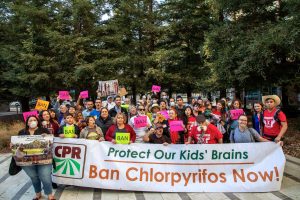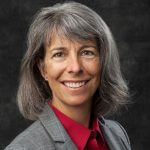Nayamin Martinez
Fresno, California
This interview was conducted by Carly Schmidt on October 25, 2019.
What is your role at the Central California Environmental Justice Network (CCEJN)?
I am the director at the CCEJN and we are based in the Central Valley where we work in almost all of the eight counties. My role is really interesting because it allows me to interact with a variety of stakeholders. Yes, I go to committee meetings and canvas to get to know the stories and problems in our community, but I also have the privilege of being able to represent their voices at the state level. For example, I attend state hearings and make sure that regulations and enforcement decisions are made with the voices of these communities.
The mission of your organization is to “is to empower our communities and secure our children’s future by eliminating negative environmental impacts.” What are you doing these days to tackle these huge objectives?
Unfortunately, the Central Valley is ground zero for many environmental injustices. Water is, of course, one of them. We just came out of one of the most severe droughts in the history of our state. This is something that affects disadvantaged communities. Especially those who rely on private wells that went completely dry. In some cases, smaller communities had to be connected to the closest city’s water system. The drought also worsened contamination problems as a result of the economic activity of our area, which is agriculture and oil extraction. The lack of affordable, safe drinking water in our communities has been a top priority for us. We, unfortunately, also have the worst air quality in the nation which is, again, the result of the main industrial sectors in our area. Our work tries to tackle all these issues together for a holistic approach that is place-based and responsive to our communities’ needs.
Since we had a lot of water shortage and contamination problems in the Valley, this has been one of our major campaigns. Of course, we never work alone. We are part of a network of regional and state allies.
Have you had any major victories recently?
We had a major success in mid-July this year when the safe drinking water fund was finally signed into law by the new governor, Gavin Newsom (read more about California SB 200 here). The official signing of the bill was done at the home of the Garcia family, one of the residents we had been working closely with in a small rural community outside of Fresno. This family was so close to my heart because we had been working with them for at least four years. One summer the mother called me crying. It was over 100 degrees, she was 6 months pregnant and had two toddlers. She was crying because her well finally went completely dry and she couldn’t give her kids anything to drink. Having to tend to these calls is so painful. We had to come up with short-term solutions at a time when the state had shut down their temporary relief programs to help families like the Garcias, who are low-income farm workers. We collected funds and brought water to this family. Eventually their water came back, but it was in this home that the governor came to meet with her, hear her story, and sign that bill.
How do families like the Garcias connect with you when they’re having water accessibility issues?
CCEJN has run a reporting network called IVAN: Identifying Violations Affecting Neighborhoods, since 2013. People can go to an online portal and we channel their reports to agencies who are responsible for the issue. This is how we got the first report to the city where the Garcia family resides that residents were in trouble. We helped the reporter apply for a program to get water and a new well drilled. A few years went by and we were still getting reports from the same community. We started canvassing, knocking on doors and asking if this has happened to others. This is how we met the Garcia family.
IVAN helps us hold regulatory agencies accountable to the community members that they serve. Once a month we convene task force meetings where we bring together regulatory agencies and community members who submit reports so frustrations can be heard and agencies can share what they are doing to address the problem. In some instances, there are tough discussions, but it’s a real opportunity for these communities to be heard. We see ourselves as the bridge between these two stakeholders.
When you were running through your programs and what you do to achieve your mission you said, “unfortunately,” so many times, which is so reflective of the fact that if injustices or problems didn’t exist, we wouldn’t be employed. What do you do to stay motivated in this work?
Yes, I wish I was out of a job! What we try to do is not only criticize and call out the wrong that is happening, but also come up with solutions. I’ll give you an example because this is one of my favorite programs right now.
Given all these issues here and that many of our members are farm workers, many of them have expressed a desire to go back to the old days, when we didn’t rely on pesticides, and return to more natural methods. After hearing these ideas over and over, we designed an agro-ecology program for the Central Valley. We are bringing together small farmers that are struggling and farm workers who want to become farmers without replicating practices of the agricultural industry. They’re more interested in permaculture and methods that allow people to be less dependent on chemicals. This is our attempt to say we have optimism that if we change our ways we can continue living here with the resources we have and do our best to mitigate climate change through this work.
You have so much going on and such ambitious goals – how many people are on your staff?!
That’s the more interesting question! We have grown so much. I have been with the organization for almost four years and when I started we were two staff. Now we are six. That’s it!
Given the fact that you have such a small staff and there is no shortage of environmental injustices and opportunities to address them, what keeps you energized and motivated in this work?
Even the small wins, and some are not small. It has been a wonderful year for us. Not only did we have the safe and affordable water fund pass, but we’ve also been trying to get rid of one pesticide called chlorpyrifos that damages young children’s brains. We’ve been fighting at national and state levels and in April the new governor started the cancellation process. Unbelievably, the company reached an agreement with the state and they’re stopping sales next month. These wins really keep us going.

Photo courtesy CCEJN.
How do you work with your community members in practice?
Individuals and organizations are part of our network, distributed in all eight counties. It’s an informal network. There’s a declaration that you agree with our mission and you become a member. Then, you can access our information and resources. We recently developed an environmental justice curriculum and our members will get this guide first before we distribute to others.
What do you do particularly well in engaging these members?
A lot of our members are grassroots groups, like community and neighborhood level groups. A lot of them are not English speakers and a lot of them don’t understand the complexity of the regulatory agencies here in our state. What we do is represent them, but also train them on how to present their comments in meetings in Sacramento. We are also their ears and eyes about what’s going on at the legislative level so they can have a strong voice.
One thing we have done particularly well is rely on the model of citizen science. For us, the community members are the experts of their neighborhoods. We teach them the skills to collect samples of VOCs or take samples of wells. We offer this training to residents and they can go back and use it in their own advocacy campaigns.







